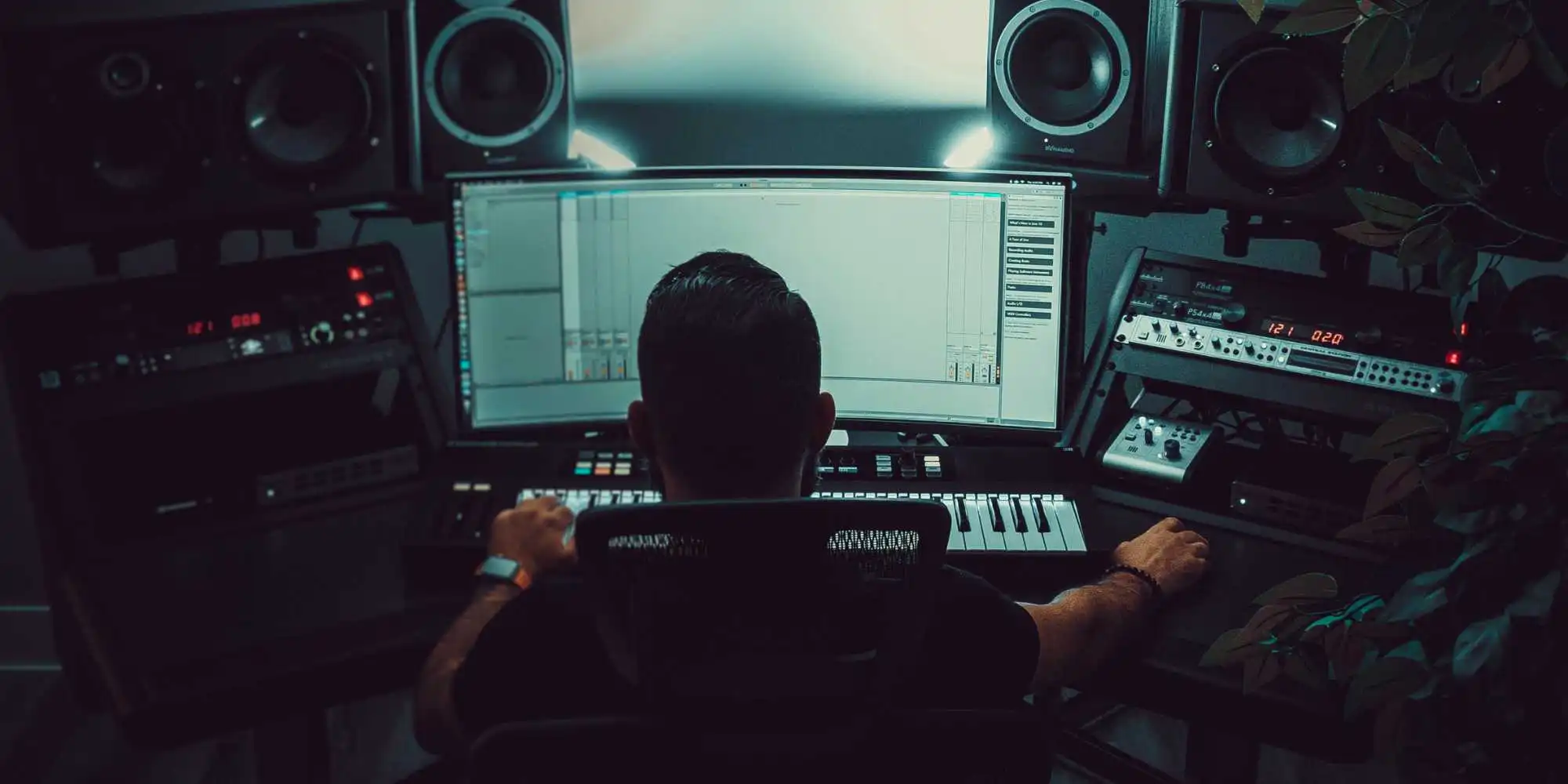The best monitor size for typical music production is 32 inches, although your particular needs outside of music production may require a smaller or larger monitor.
The right monitor can make a music producer’s job easier, more comfortable and productive.
We understand that there are many factors to consider when choosing the ideal monitor size for music production, and we’re here to help.
This guide will help you decide which monitor size is right for your DAW production needs.
Once the monitor size is established, our in-depth guide on the best monitors for music production will help with monitor selection.
Points to Consider for Monitor Size
As much as we love 32-inch monitors for music production, there is no one-size-fits-all choice.
But there are a few factors most music producers should consider when choosing a monitor for DAW music production.
What type of work do you need the monitor for other than music production?
Most music producers do more than just produce music on their computers.
Ultrawide monitors are great for producing music with long timelines and multitasking with several different windows open at once on one monitor.
But browsing the web, responding to email, and other day-to-day tasks on an ultrawide monitor is obnoxious.
And gaming is even worse because many games aren’t designed for the screen resolution of an ultrawide monitor.
Most users will have a better experience with a dual-monitor setup instead of a single ultrawide monitor.
How much space do you have?
A single 32-inch monitor has a smaller desk footprint than a larger, ultrawide monitor, so a smaller monitor is a logical choice for small desks.
But if you need more screen real estate than a 32-inch monitor offers, you have two options – buy a larger monitor, or use a dual-monitor setup.
Two monitors side-by-side certainly take up more desk space than a single ultrawide monitor.
But some dual-monitor systems hold one (or both) monitors on a movable positioning arm, which takes them off your desk altogether.
What are your deal-breaker, must-have features?
The larger the monitor, the less likely it is to have ergonomic adjustment features such as height, tilt, and pivot, making long production sessions painful.
Plus, if you plan on upgrading (now or later) to a dual-monitor setup, this lack of adjustment can make it challenging to line up your monitors correctly.
Read the features of each monitor carefully to ensure you’re getting all your must-haves before you buy.
Ultrawide Monitors for Music Production: The Industry Standard?
It’s a bit of an exaggeration to call ultrawide monitors the “industry standard” for music production.
Sure, they have their uses, but the drawbacks outweigh the benefits for most users.
An ultrawide monitor gives you more real estate to multitask with several different programs or screens open at one time.
But full-screen browsing, gaming, and streaming are all kind of a pain.
And we do mean literal pain because of all the side-to-side neck turn required to see the entire screen width.
But they can be a figurative pain, too.
Streaming services such as Netflix and Hulu perform well enough for more recent shows and movies shot in a 21:9 aspect ratio.
But older shows, movies, and most YouTube videos will display black bars on the sides of the window in full-screen mode, which is distracting.
And some games aren’t even built with this aspect ratio in mind.
Music producers who do lots of work with long timelines or score writer software like Sibelius can get more measures on the screen with an ultrawide monitor.
But, in most cases, you can accomplish the same thing with two thin-frame or frameless monitors in a dual monitor setup for a fraction of the price.
Best Ultrawide 38-Inch Monitor for DAW Production
Best For: Long timelines
LG 38WN75C-B
This ultrawide monitor from LG offers plenty of horizontal space for even the longest timelines so that you can see more measures at once.
The curved display reduces neck turn, and the height-adjustable stand maximizes ergonomic comfort during long production sessions.
43-Inch Monitors for Music Production: Are They Too Big?
A 43-inch monitor is more than most producers need for general music production, but that doesn’t mean it’s a bad fit for everyone.
Advanced music producers with complex workflows can get a significant amount of value from a monitor of this size for specific use cases, but it’s overkill for most.
Unlike ultrawide monitors, a 43-inch monitor has a standard aspect ratio, which means you have plenty of vertical and horizontal real estate to work with.
This is useful if you often work with several different effects, instruments, tools, or programs at one time.
But all that space means lots of side-to-side and up-and-down head turning, leading to neck strain.
You can minimize this risk by putting plenty of space between yourself and your monitor – an arm’s length, at least – and putting your less frequently used tools at the top of the screen.
The aspect ratio of a 43-inch monitor is better suited to day-to-day tasks such as email, browsing, and gaming than an ultrawide monitor.
But we still prefer a smaller monitor and dual-monitor setup for an all-around comfortable user experience.
Best 43-Inch Monitor for DAW Production
Best For: Advanced DAW production workflows
Dell U4320Q
Most 43-inch monitors have limited adjustment, but this one from Dell can tilt, swivel, and adjust as needed for maximum comfort.
We recommend mounting it on the wall to reduce eye strain, but the stand has a small footprint for desktop use.
32-Inch Monitors for Music Production: Just Right?
This is the “Goldilocks Zone” of monitors for music producers.
A 32-inch monitor has the right amount of screen real estate for most workflows without making daily tasks like email, streaming, and web browsing unpleasant.
There’s enough room to have two or three programs and several vertical tracks open on the screen at once.
What’s more, you can maximize your productivity with a dual-screen setup, which gives you more working area than a single larger monitor anyway.
Almost anything you can do with an ultrawide monitor, you can do with a more versatile multiple-screen setup of 32-inch monitors.
A dual-screen setup also allows you to mix-and-match monitor sizes, adding as many displays as you need for your ideal workflow.
That’s probably why this is the arrangement of choice for most experienced music producers.
Best 32-Inch Monitor for DAW Production
Best For: Intermediate to advanced music production; producers who need more desktop space or to increase text or UI elements without losing screen space.
LG 32UP83A-W
You can mount this 32-inch monitor from LG on the wall, making it easy to put the ideal distance between yourself and your monitor.
The UHD display is excellent for gaming, streaming, and music production.
It’s got a near-borderless design on three sides, so it offers a pleasant dual-screen experience.
27-Inch Monitors for Music Production: The Perfect Runner Up?
We recommend 27-inch monitors for beginner to intermediate music production, especially if you spend most of your time on other computer tasks.
A 27-inch monitor is just as valuable for most music producers and everyday users as the ideal 32-inch monitor, especially when using a dual-monitor setup.
Browsing the web, checking email, streaming, and gaming are much easier on a 27-inch monitor than even a slightly larger 32-inch one.
You still get plenty of screen real estate with a 27-inch monitor, but the smaller size makes it more comfortable for everyday use.
And, as always, if you need more screen real estate, you can always use a dual-monitor setup.
Two 27-inch monitors have a much smaller footprint than two 32-inch monitors, which is awesome for users who like to multitask but have limited desk space to work with.
Overall, we think that a 27-inch monitor is an excellent size for general music production and everyday use.
Best 27-Inch Monitor for DAW Production
Best For: Beginner to intermediate music production, web browsing, email, and everyday tasks. An excellent all-around size for most users.
LG 27UP650-W
We love this 27-inch monitor from LG because its nearly borderless design is excellent for dual-screen setups.
It’s height, pivot, and tilt-adjustable, so it’s easy to position comfortably.
And you can get two for less than the price of a single ultrawide monitor.
No 24-Inch Monitors?
In generaI, we wouldn’t recommend a 24-inch monitor to most music producers.
The limited screen space means you’ll be switching between tools and programs constantly, which is a considerable drain on efficiency.
If you absolutely must get a 24-inch monitor, we recommend going with the HP VH240a.
Its thin frame design makes it easy to upgrade to a dual monitor setup, which you should do ASAP.
Parting Notes
The truth is, there is no one-size-fits-all monitor.
The best monitor for music production is the one that maximizes the music producer’s comfort, efficiency, and productivity.
Besides, the monitor that fits your needs today may not be a great fit a year from now as your needs change.
Get the monitor that works for you now, and if you need to upgrade again later, you can.
As Mark Zuckerberg says, “Move fast and break things.”
FAQ
Questions about monitors for music production? We have the answers.
Yes, music producers need enough screen space to have their most essential tools and programs open at once.
Yes, a 24-inch monitor is too small for most music producers.
Even upgrading to a 27-inch monitor gets you about 25 percent more work space.
For most music producers, choosing between a 27 and 32-inch monitor is essentially a matter of personal preference.
In general, the distance between you and your monitor should be 1.5 to 2.5 times the diagonal width of the monitor.
In the case of a 32-inch monitor, that means you should sit between 48 and 80 inches (roughly 4 to 6 feet) from the screen.
Yes, while it will take a couple of weeks to adjust to a dual-screen workflow, you’ll experience almost immediate and lasting improvements in productivity.






